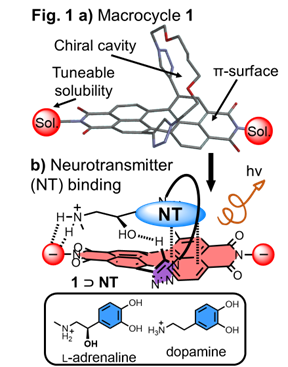Chiral sensors for neurotransmitters
Principal Supervisor: Dr Timothy Barendt
Secondary Supervisor(s): Dr Dirk-Peter Herten
University of Registration: University of Birmingham
BBSRC Research Themes: Understanding the Rules of Life (Neuroscience and Behaviour, Systems Biology)
No longer accepting applications
Project Outline
Combining research in chemistry and biology, this PhD project will develop optical probes to sense neurotransmitters, important bio-markers for understanding and treating neurological diseases.
From molecular synthesis to cell biology, this project will equip the candidate with a multi-disciplinary skillset, including techniques commonly used in industrial and academic research. This project will develop critical thinking and problem-solving, essential skills that translate outside of research and development
Background
Neurotransmitters (e.g. dopamine) are key molecules in neuronal communication, making their detection and quantification vital for medical diagnostics and therapeutics.1 According to the ‘Disability Adjusted Life-Year’ ranking, neurological diseases are the leading cause of disability worldwide.2 While the concentration of a neurotransmitter can be determined using electrochemical methods, it is still challenging to identify which neurotransmitter is being released by a cell. This is because neurotransmitters have similar molecular structures. Fluorescence sensors for neurotransmitters that are capable of the strong and selective binding of neurotransmitters remain elusive.

This project will use perylene diimide,3 an organic fluorophore, to develop non-toxic and non-intrusive optical probes for sensing neurotransmitters in biological media. The key novelty is that the proposed receptors are macrocycles that form configurationally stable enantiomers (Fig. 1a). Many neurotransmitters are also chiral molecules. This opens up the exciting possibility of using stereoisomerism for the selective recognition and sensing of chiral neurotransmitters (e.g. L-adrenaline > dopamine, Fig. 1b).
Our preliminary work has shown that perylene diimides can bind neurotransmitters in water [Ka = 103 M–1]. With the aim of enhancing binding strength and selectivity, this project will integrate a perylene diimide into a preorganised receptor, i.e. macrocycle 1 (Fig. 1a). This receptor is designed to be a selective chiroptical probe for neurotransmitters: it is metal-free, emits at low energy and has a preorganised, chiral binding site.
Objectives
We hypothesise that macrocycles such as 1 will have enhanced selectivity for binding a chiral neurotransmitter, delivering selective sensors. The key objectives are:
- Integrate the perylene diimide fluorophore into a macrocyclic receptor.
- Resolve the receptor enantiomers and characterise them.
- Quantify binding and optical sensing of neurotransmitters in biological media.
- Perform bio-compatibility and bio-imaging studies in vitro.
Methods
Located in chemistry and biology laboratories, the project has four components that map onto the project objectives:
- Synthesis (Barendt lab): We will prepare a library of perylene diimide macrocyclic receptors. Synthesis will be based on established procedures. Key will be to install dendritic carboxylates to impart solubility in biologically-relevant media.
- Receptor resolution (Barendt lab): We will prepare enantiomerically pure receptors that are configurationally stable under physiological conditions (up to 40 °C) using chiral high performance liquid chromatography (HPLC). This technique will also determine interconversion barriers.
- Neurotransmitter binding (Barendt & Herten labs): Titration experiments (isothermal titration calorimetry) will quantify neurotransmitter binding in aqueous media, supported through computational modelling. Fluorescence spectroscopy will assess optical sensing capabilities.
- Biosensing (Herten lab): We will determine the biocompatibility of the sensors (cytotoxicity measurements and cell uptake studies) and their aqueous- and photo-stability. Neurotransmitter sensing will be tested in vitro using fluorescence microscopy.
References
[1] J. Neurosci., 2003, 23, 5835. [2] W. M. Carroll, Lancet Neurology, 2019, 18, 418 [3] Chem. Rev., 2016, 116, 962.
Techniques
The candidate will develop a multidisciplinary skillset through training and performing the following techniques:
- Synthetic chemistry.
- Compound purification (chiral HPLC) and characterisation (e.g. NMR spectroscopy, mass spectrometry).
- Photophysical analysis (UV-vis and fluorescence spectroscopies).
- Binding studies (isothermal titration calorimetry and molecular modelling).
- Cell biology (HeLa cell growth and manipulation, cytotoxicity and uptake studies).
- Fluorescence microscopy (super-resolution microscopy and image analysis).